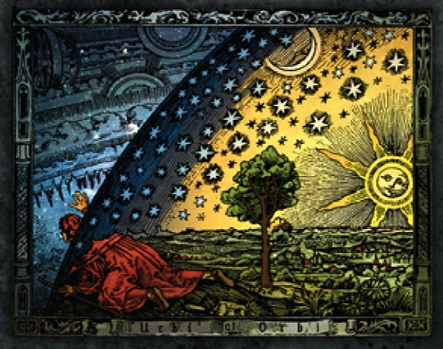The following is excerpted from The Astrological Revolution: Unveiling the Science of the Stars as a Science of Reincarnation and Karma, available from Steiner Books.
One of the beneficial aspects of the contemporary rediscovery of the Mayan calendar's "end date" has been the attention brought to bear on astrology. Though the systems have changed over the millennia, the constant fundamental proposition of all astrological knowledge systems is that the rhythms of the planets against the stars play into human life — and the arc of human history. The calendrical phrase "2012" has in a way become our era's signal short hand for this conception.
The Reality Sandwich community has been instrumental in fostering conscious striving toward an exposition of human consciousness, in the expectation that the ancient Mayan priest-astronomers intuited a spiritual event of great magnitude centering on the year 2012. In our book, Christ & the Mayan Calendar: 2012 and the Coming of the Antichrist, we presented a challenging aspect of the spiritual events of our time; in our new book, The Astrological Revolution: Unveiling the Science of the Stars as a Science of Reincarnation and Karma (Lindisfarne Books: 2010), based on the past 30 years of Robert Powell's reincarnation research, we offer a tool foraiding one extremely hopeful development of our time — the birth of a new star wisdom, coincident with the continuing incarnation of the Divine Sophia. The excerpt below introduces the importance of Rudolf Steiner's statement from 1912 as a seed for Robert's astrological reincarnation research.
Introduction:Seth's Pillars
On a fine spring day in April 1914, a detective from the New York City Police Department walked into a luxury suite in the Carnegie Hall Building at Seventh Avenue and Seventy-Fifth Street and arrested Miss Evangeline Adams for fortune-telling. The dozen or so fashionably dressed men and women who waited in the reception room may have included Enrico Caruso or Mary Pickford or Charlie Chaplin, for these and other New York notables were among her clients. Ever since her arrival in Manhattan in March 1899, Evangeline Adams had been a crafty self-promoter whose invented Boston Brahmin roots (she claimed, untruthfully, that she was descended from John Adams) were intended to lend respectability to her profession of astrology. Though Caruso swore that he never crossed the Atlantic without first finding from Miss Adams the day propitious for sailing; though Miss Adams's client J. P. Morgan is often quoted as having said "Millionaires don't use astrology. Billionaires do!" (a quote invented by Evangeline Adams!); though half a million CBS radio listeners eagerly sent in their birth information with a box top from Forhan toothpaste in hopes of having Evangeline Adams cast their horoscope on the air; and though Judge John J. Freschi reputedly (again, the only source is Adams herself) declared upon acquitting Adams of that charge of illegal fortune-telling: "the defendant raises astrology to the dignity of an exact science," astrology has not achieved such dignity, even though film stars, judges, presidents, and Everyman have found it helpful in understanding the puzzle of their own biographies.
At nearly the same moment as Evangeline Adams was being arrested, a much younger science — Assyriology, the linguistic, historical and archaeological study of ancient Mesopotamia and neighbouring cultures — was bringing forth discoveries that would eventually lead to a much clearer understanding of astrology's ancient roots in the Near East. In the nineteen-teens and twenties, The New York Times regularly carried sensational reports of archaeological finds from Babylon, Ninevah, Nippur, and other ancient cities. Some of the vast number of cuneiform clay tablets which held the long lost secrets of Babylonian star lore made their way to American museums — including the Metropolitan Museum and J. P. Morgan's private library on Madison Avenue. In 1910, Morgan gave Yale University $100,000 in U.S. Steel stock to found a professorship in Assyriology. Cuneiform-pondering linguists and Indiana Jones-style tablet hunters became popular figures in novels, film, and plays. The word "decipher" showed up frequently in headlines and advertising copy, the quest to penetrate the mysteries of Babylonian culture seizing the national imagination in a way unseen since Champollion's translation of the Rosetta Stone in the 1820s. Americans' enormous interest in the Near East reflected a widespread desire for some affirmation of Old Testament truths in the face of the brash new religion of Darwinism. The clay tablets told epic stories of the gods — Ea, Marduk, Nabu, Inanna — and of a primeval Flood, and of the movements of the planets against the backdrop of the stars. For the fast and fleeting "flapper" generation, there was the reassurance of cosmic permanence in the simple triangular marks in the clay.
Near the end of the first century AD, the Roman historian Josephus wrote in his Antiquities of the Jews of how Adam, the first human being, instructed his son Seth to erect two pillars — one of brick and another of stone –depicting knowledge of the starry heavens. Adam's plan was that if the brick tablet were destroyed in the Flood, the stone one would survive to teach humanity what was written on it. Josephus could not have known just how often that brick tablet would become lost, damaged, misread, scoffed at,ignored, and condemned over the twenty centuries that followed. Like the knowledge of the fairy world, which has ever and always been "going away" — vanishing from human sight — while simultaneously coming into view in new forms, Seth's descendants' knowledge — astrology — has perennially perished in the flood of rationalism, materialism, and scientism (not to mention charlatanry) that has deluged and drowned this ancient arena of human experience. That moment in Manhattan in 1914 is just one of countless paradoxical simultaneities down through the centuries, when astrology seemed to be suffering its death throes at the same moment as being born anew.
At nearly the same moment as the tarnished brick pillar of Evangeline Adams's Seventh Avenue astrology and the clay tablets from Ninevah or Nippur were so widely celebrated, the stone pillar was reappearing, though few took notice then or now. About a year before Miss Adams's arrest, in Strasbourg, France, Rudolf Steiner gave the last in a series of lectures on "The Life of the Soul Between Death and Rebirth." Steiner had delivered these lectures over a period of seven months in nearly a dozen cities — Milan, Hanover, Vienna, Bern, Linz, Tübingen, Frankfurt, Munich, Breslau, Düsseldorf, and Strasbourg — and there was a palpable quality of "research in progress" in them. Joking asides and small anecdotes alternate with vast, esoteric panoramas to portray the mysterious voyage of the human soul after death, as well as the playing into one life of the deeds and decisions of the previous life, via the records inscribed in the starry world. Given the sweeping scope of these lectures, one might easily pass over a small passage like this one:
When a person passes through the gate of death he dies under a certain configuration of stars. This configuration is significant for his further life of soul because it remains there as an imprint. In his soul there remains the endeavor to enter into the same configuration at a new birth, to do justice once again to the forces received at the moment of death. It is an interesting point that if one works out the configuration at death and compares it with the configuration of the later birth, one finds that it coincides to a high degree with the configuration at the former death. [Rudolf Steiner, Life between Death and Rebirth, p. 97. (Lecture given November 28, 1912, in Munich)]
From his remarks just before this passage — "The fact. . . came to me in an extraordinary way during the investigations of the last few months" — Rudolf Steiner clearly indicates that this was a very recent discovery for him. He also held back from stating this discovery about the relationship between death and rebirth as "a general law." As with so much of the remarkable knowledge that he brought into the world, Rudolf Steiner left a tremendous amount unsaid about his discovery, opening up the possibility for future researchers to clarify and extend the findings of his own spiritual research.
For Robert Powell, this single paragraph from a 1912 lecture became a Rosetta Stone — or, in the sense of Josephus's parable, a "pillar of stone" — for his research into the mysteries of karma and reincarnation, as revealed by a study of the stars. The scientific principles he outlines in this book are themselves stone pillars, ones that humanity can take up with confidence at this time, no matter how many brick pillars have been lost, eroded, and corrupted over the intervening centuries since the Babylonian astrologers looked up into the night sky.















